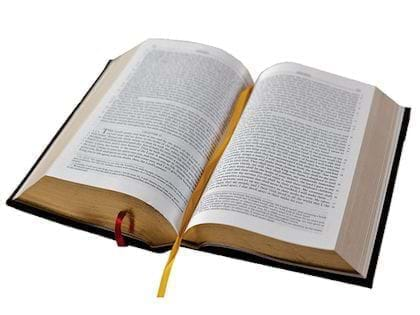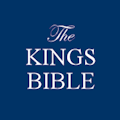- Parallel Bibles
- Old Testament
- Matthew
- Mark
- Luke
- John
- Acts
- Romans
- 1 Corinthians
- 2 Corinthians
- Galatians
- Ephesians
- Philippians
- Colossians
- 1 Thessalonians
- 2 Thessalonians
- 1 Timothy
- 2 Timothy
- Titus
- Philemon
- Hebrews
- James
- 1 Peter
- 2 Peter
- 1 John
- 2 John
- 3 John
- Jude
- Revelation
- Old Testament
King James Bible History
|
In the preface to the 1611 authorised version the King James’s translation committees said they did not seek "to make a new translation, nor yet to make of a bad one a good one, but to make a good one better". What we can understand from this is when it comes to "translators" Tyndale is included among them as the original and probably the best. In the making of the King James Bible; Tyndale and the translators of the other Bibles used by the King James’ committees are all present in this great work of literature. The result leaves little doubt as to why so many people believe the King James Bible is the inspired work of God. In 1525 William Tyndale produced the first printed translation of the New Testament in English. Over the next ten years, Tyndale revised his New Testament, and embarked on a translation of the Old Testament. Tyndale made some controversial translation choices, but the merits of his work and prose style made his translation the ultimate basis for all subsequent renditions into Early Modern English including the King James Version. 1539 - The official Great Bible with a preface picturing Henry VIII, was produced for reading aloud in churches and it used much of Tyndale's previous work. Edited and adapted by Myles Coverdale, Tyndale's New Testament and his incomplete work on the Old Testament became the basis for the Great Bible. This was the first "authorized version" issued by the Church of England during the reign of King Henry VIII. 1560 - The Geneva Bible was published. When Mary I succeeded to the throne in 1553, she returned the Church of England to the Roman Catholic faith and many English religious reformers fled the country, some establishing an English-speaking colony at Geneva. Under the leadership of John Calvin, Geneva became the chief international centre of Reformed Protestantism and Latin biblical scholarship. These English expatriates undertook a translation that became known as the Geneva Bible. 1568 - The official Bishops' Bible was published. Soon after Elizabeth I took the throne in 1558, the flaws of both the Great Bible and the Geneva Bible became painfully apparent. In 1568, the Church of England responded with the Bishops' Bible, a revision of the Great Bible in the light of the Geneva version. While officially approved, this new version failed to displace the Geneva translation as the most popular English Bible of the age. 1601 - A meeting of the General Assembly of the Church of Scotland took place in Fife, which was attended by King James VI of Scotland. It was at this meeting that the proposal for a new translation of the Bible was first raised. 
King James I of England (1576–1621) 1603 - James VI of Scotland became James I, King of England. 1604 – King James I convened the Hampton Court Conference to discuss the future of the church. It was at this meeting a new English version was proposed in response to the perceived problems of earlier translations as detected by the Puritan faction of the Church of England. At the time the king said that he: "Could never yet see a Bible well translated in English; but I think that, of all, that of Geneva is the worst. I wish some special pains were taken for an uniform translation, which should be done by he best learned men in both Universities, then reviewed by the Bishops, presented to the Privy Council, lastly ratified by the Royal authority, to be read in the whole Church, and none other." As a result a resolution was made: "That a translation be made of the whole Bible, as consonant as can be to the original Hebrew and Greek; and this to be set out and printed, without any marginal notes, and only to be used in all churches of England in time of divine service." King James gave the translators instructions intended to guarantee that the new version would reflect the structure of the Church of England and its beliefs about an ordained clergy. The translation was undertaken by 47 scholars, all of whom were members of the Church of England. In common with most other translations of the period, the New Testament was translated from the Textus Receptus (Received Text) series of the Greek texts. The Old Testament was translated from the Masoretic Hebrew text, while the Apocrypha were translated from the Greek Septuagint (LXX). 1608 – The main translation was completed and was submitted for editing. From January 1609, a General Committee of Review met at Stationers' Hall, London to review the completed marked texts from each of the six committees. The General Committee included John Bois, Andrew Downes and John Harmar, and others known only by their initials, including "AL" (who may be Arthur Lake), and were paid for their attendance by the Stationers' Company. John Bois prepared a note of their deliberations (in Latin) - which has partly survived in two later transcripts. Also surviving is a bound-together set of marked-up corrections to one of the forty Bishops' Bibles - covering the Old Testament and Gospels, and also a manuscript translation of the text of the Epistles, excepting those verses where no change was being recommended to the readings in the Bishops' Bible. 
Archbishop Richard Bancroft Archbishop Richard Bancroft was the chief overseer of the authorized version of the Bible. Bancroft insisted on having a final say, making fourteen changes, of which one was the term "bishopricke" at Acts 1:20. He died at Lambeth Palace on 2 November 1610. 1611 – The King James Bible was published, the complete title page reading: "THE HOLY BIBLE, Conteyning the Old Testament, and the New: Newly Translated out of the Originall tongues: & with the former Translations diligently compared and revised, by his Majesties Special Commandment. Appointed to be read in Churches. Imprinted at London by Robert Barker, Printer to the Kings most Excellent Majestie. ANNO DOM. 1611." The King James Bible was printed with small italicized Roman type to represent those words not in the original languages. |


 he King James Bible is a descendent of William Tyndale’s great translation
of the century before. When King James commissioned his Bible he gave specific instructions to the translators to use the best
from the Bishops' Bible, Tyndale's Bible, Coverdale's, Matthew's, and Geneva Bibles.
he King James Bible is a descendent of William Tyndale’s great translation
of the century before. When King James commissioned his Bible he gave specific instructions to the translators to use the best
from the Bishops' Bible, Tyndale's Bible, Coverdale's, Matthew's, and Geneva Bibles.